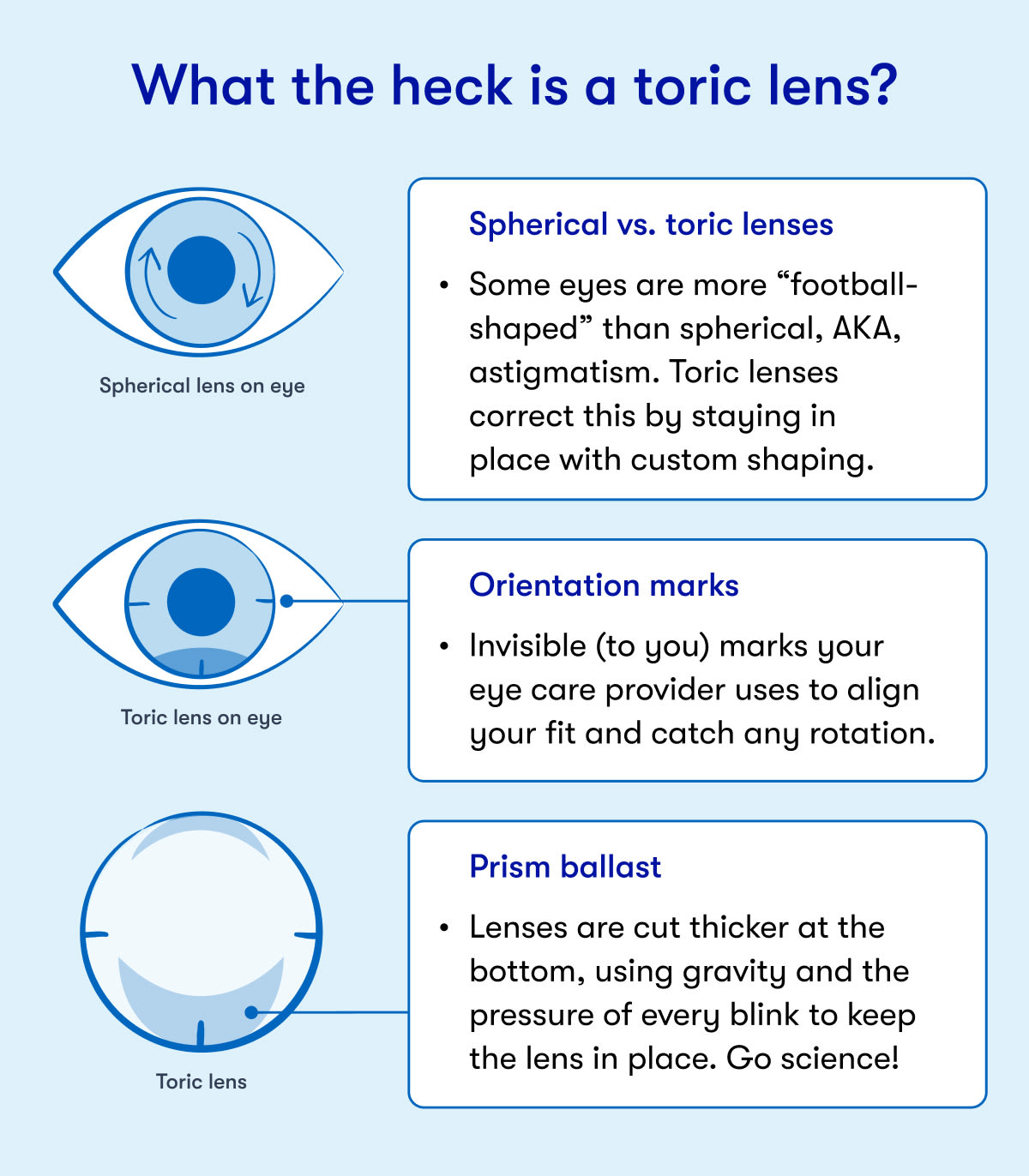What are toric contact lenses?
Toric contact lenses are a special type of soft lens designed to correct astigmatism (a fancy word for when your eye isn’t shaped like a marble but more like a football). Unlike standard lenses, toric lenses have different powers in parts of the lens to fix the uneven way light enters your eye. They’re the overachievers of the contact lens world — doing more work so you can read a street sign or recognize your friend across the room (instead of smiling vaguely at strangers and hoping for the best).
These lenses go by a few names, including astigmatism contacts, toric soft lenses, astigmatism correcting intraocular lenses, and sometimes, "contacts that cost more but make the blur go away."
How do astigmatism contacts work?
To understand how toric lenses work, it helps to understand astigmatism. If your eye was a camera, astigmatism would be like having a slightly warped lens that makes everything look stretched or fuzzy. Toric lenses fix that by acting like a tiny custom lens map built just for your eyeball and vision.
They also come with a built-in stabilizing design (like a weighted edge or special shape) to keep them in place. That’s important because if they spin or slide, your vision can go from crystal clear to not ideal. (Suddenly, you’re back to guessing which blurry blob is your car.)
Do astigmatism contacts have lines?
Yes, but the lines don't mess with your vision. They’re called orientation marks, and they help your eye care professional check whether your lenses sit in the right spot. Most of the time, you don’t even notice them. (And no, people can’t see them unless they’re way too close.)

Toric lenses vs. regular contacts
Regular contact lenses (aka spherical lenses) correct nearsightedness or farsightedness. They’re the standard go-to for most people, but they’re not built to handle the extra optical gymnastics that astigmatism requires.
Toric lenses are specially shaped and stabilized to deal with the way light scatters when your cornea isn’t perfectly round.
Here’s a quick side-by-side:
-
Toric lenses for astigmatism: Designed with multiple powers across the lens and a weighted design to stay in place; correct both the spherical and cylindrical components of your prescription
-
Non-toric lenses: Designed for basic vision correction (nearsightedness or farsightedness) without astigmatism; have the same power throughout
If your prescription includes a cylinder and axis, you’re in the toric camp.
Are astigmatism contacts thicker?
Yes, generally speaking, toric lenses tend to be thicker than non-toric ones because they need extra structure to stay oriented correctly in your eye. (Imagine trying to get a picnic blanket to lie flat on a windy day.)
That said, thickness can vary between brands and materials. Some toric lenses might measure around 0.09 millimeters thick, while standard lenses hang out closer to 0.07 millimeters — not a huge difference but enough to notice if you’re used to the thinner feel.
More structure means they stay put and correct your vision better. But it also means you might feel them more at first if you're new to lenses or your eyes are sensitive divas.
Why are astigmatism contacts so uncomfortable?
Not everyone finds toric lenses uncomfortable, but if you do, you're not alone. Here are several reasons why this may be the case:
-
They're thicker than standard lenses, which can make their presence noticeable at first.
-
Stabilizing features, such as ballast or prism designs, can create slight pressure points that take some getting used to.
-
They move around less, which is great for vision but means your eye has to adjust to a more rigid fit.
-
Poor fit or dry eyes can make even the fanciest lens feel like a tiny desert island in your socket.
-
They’re not all created equal — sometimes a different brand or material is the game changer your eyes are waiting for.
If your lenses feel uncomfortable after the adjustment period (usually a few days), talk to your eye care professional. They may recommend a better match for your blink style and hydration levels.

Order Contact Lenses Online
Learn how to order contact lenses online at 1-800 Contacts
Order contacts
If you have astigmatism, can you wear regular contacts?
Probably not, unless your astigmatism is super mild and your eye care professional gives it a thumbs-up. Regular contacts can’t correct the uneven curvature in your eye the way toric lenses can. So even if they kind of work, you might still see a little fuzz or feel more eye strain by the day's end.
The bottom line is to follow your prescription. Your eye care professional didn’t spend years studying ocular science so you could wing it with the wrong lenses to save a few bucks.
Can people with astigmatism wear colored contacts?
Yes, you can absolutely wear colored contacts if you have astigmatism, as long as they’re designed for it.
Not every brand offers toric lenses in colors, so the selection might be smaller, but they do exist and can be stunning. Just make sure you're buying FDA-approved lenses with a valid prescription. No sketchy costume-shop contacts, please.
Want to see how it works? Check out our guide to prescriptions for colored contacts.
How to put in contacts for astigmatism
Toric lenses are a little more high-maintenance than their regular counterparts. Here's how to give them the red-carpet treatment they deserve:
-
Wash your hands.
-
Inspect the lens to find the little lines or markers. These help align the lens properly.
-
Place it on your finger, concave side up (like a tiny bowl).
-
Look in the mirror and gently place the lens on your eye.
-
Blink gently and give it a few seconds. Toric lenses may take a moment to rotate into place.
If it feels off, take it out, rinse it, and try again. For more tips, check out our full guide on how to put in contacts and our starter guide for new lens wearers. Spoiler: It gets easier.
How are astigmatism contacts different?
Toric lenses are precision tools made to give people with astigmatism clearer vision. They’re thicker, a bit more structured, carefully designed to stay put, and often weighted to prevent mid-blink rotations that throw everything off.
If you have astigmatism and wonder whether toric lenses are worth it, they are. And once you get used to them, they’re just another (invisible) part of your daily superhero uniform.
Ready to make astigmatism a non-issue?
Your eye care professional gave you a toric lens prescription for a reason. We’ve got the exact brand and fit you need, delivered fast (no need to turn off your Netflix show).
Order your prescribed toric contacts today and start seeing the world clearly!
Did you know you can order contacts online?
Say goodbye to trips to the eye doctor and hello to convenience! With 1-800 Contacts, you can easily order your contact lenses online and have them delivered straight to your door. Plus, our online vision exam makes it simple to get the prescription you need without leaving home. And the best part? You’ll save money on your first order with 1-800 Contacts. It’s never been easier to get your contacts!

Order Contact Lenses Online
Learn how to order contact lenses online at 1-800 Contacts
Order contacts
FAQs
You might still have questions — we get it! Read below for a few more facts about toric contact lenses.
How long does it take to adjust to toric contact lenses?
Most people adjust to toric lenses in a few days to a week. Your eyes are learning to work with a new shape and fit, so give it a minute. If things still feel off after a week, reach out to your eye care professional.
Can I sleep in toric contact lenses?
It depends on the brand and specific prescription. Some toric lenses are approved for overnight wear but only under the direction of your eye care professional. (Don’t DIY this one.)
Are toric lenses more expensive?
Yes, typically, since the design is more complex and they’re made in a wider range of custom parameters. When the trade-off is seeing clearly vs. hoping that blur is your Uber, the extra cost can be worth it.
Original publish date: 5/3/2023
Updated date: 10/1/2025





